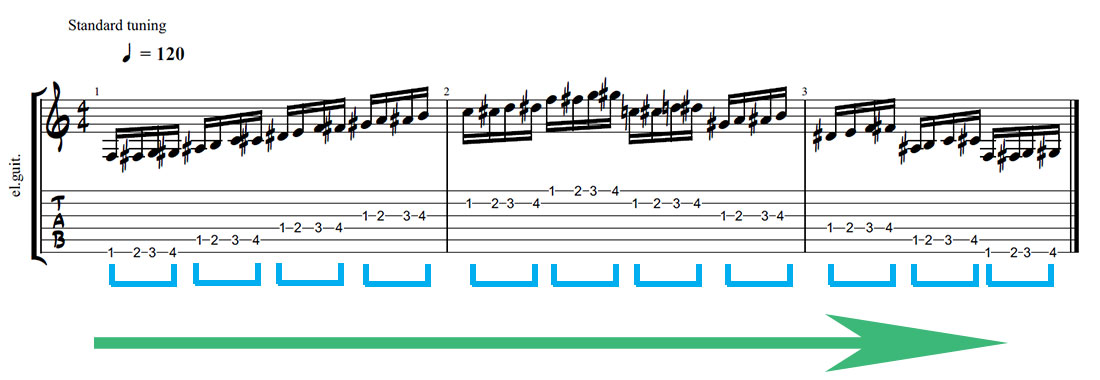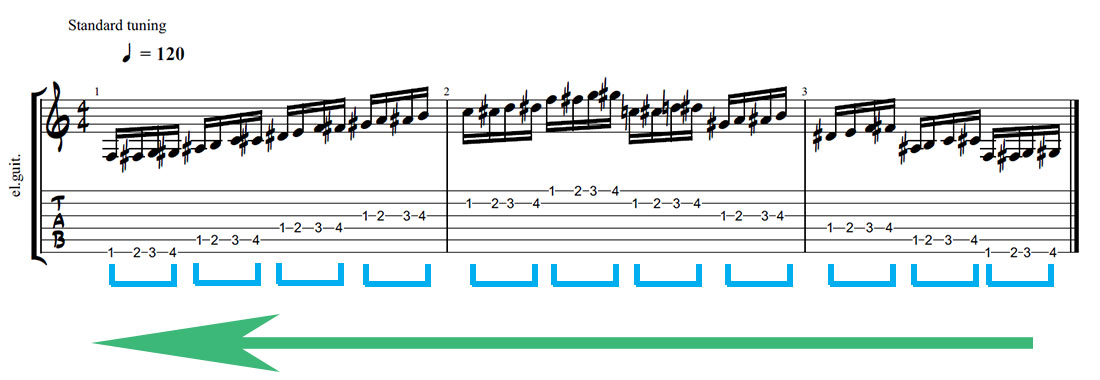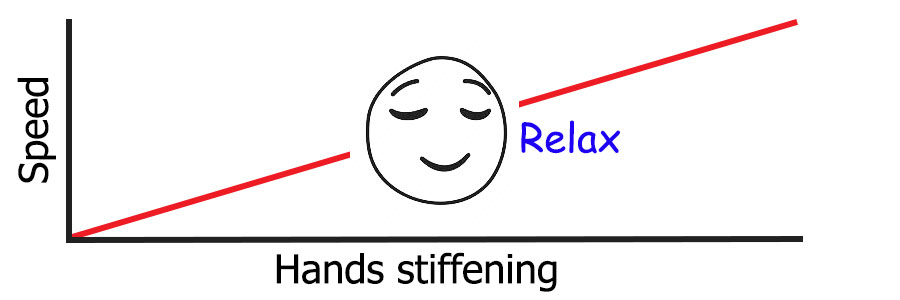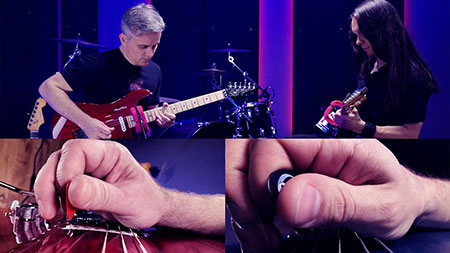How to Improve Speed on Guitar
There's a Lot More Than "Practice Slow With a Metronome"
 For many guitar players,
being able to play fast
is the Holy Grail.
For many guitar players,
being able to play fast
is the Holy Grail.
An entire generation of shredders like Paul Gilbert, Yngwie Malmsteen, Steve Vai, Frank Gambale (to name a few) has shown what is possible to achieve on our loved instrument.
Maybe you are a beginner that wants to know how to play fast and accurately like your favorite guitar heroes.
I'm not going to speculate about heart vs. technique conflict ; music is not a sport, and guitar is not a gym, but playing fast scales and arpeggios has its place in some contexts.
What's important is to be able to play any idea that comes to mind, without being limited by our technical means.
How To Get Faster On Guitar
In this article, I'm going to show you how to practice to improve your speed on guitar, going beyond the usual, boring advice that says: play slow, use a metronome, then speed will come with time.
The general advice for those who want to improve their speed on guitar is to strictly practice with a metronome , increasing the bpm little by little, and using the proper tone.
This is true for sure, especially with advanced techniques such as sweep picking, but we are only scratching the surface.
If we also include in our practice regimen the approaches I'm going to tell you, we'll get solid results faster and in a more effective way.
My suggested framework for advancing your guitar speed and accuracy is composed of the following pillars.
I've tested all these elements with many students and I can say that it's a proven system that works wonderfully.
Focus on extreme accuracy, not speed
Speed is byproduct of accuracy - Guthrie Govan
The reason why every guitar teacher on this Earth recommends to practice slow , and with the help of a metronome is accuracy.
In the beginning, we are training muscle memory to execute new movements; through repetition, the training creates new pathways in the brain that eventually will make these movements automatic.
So it's crucial to communicate to our brain the right actions that we want him to learn, which can only happen if we play at a comfortable speed.
In fact, a slow speed allows us to execute our exercises flawlessly so that the brain can learn and memorize how to move fingers without any mistake.
Now the boring stuff: you must use a metronome to develop your sense of time and keep the right beat.
Using a metronome is also useful to keep track of your progress.
You should log the bpm speed that is comfortable for you; then, once you've mastered the sequence you're working on, try increasing the speed by 5 bpm at a time.
It would immensely help if you executed any exercise with a metronome.
Bottom line: play at a speed at which your execution is perfect and increase the bpm little by little; if you take care of accuracy, speed will take care of itself.
Optimize movements to save energy and time
If you analyze carefully how fast shredders play, the first thing you'll notice is how little their hands move .
This is called economy of motion, and it's another secret for reaching higher speed on guitar.
They don't do unnecessary movements, just what is needed and no more.
- On the picking hand, this translates into a very short run between upstrokes and downstrokes .
- The fingers on the left hand are always near the fretboard, and the distance required to press a fret is minimal. Any additional movement is just a waste of energy and time , thus speed.

Bottom line: avoid all unnecessary movements and keep distances at a minimum
Occasional wild bursting to unstuck yourself
Playing with a metronome at a comfortable pace, is definitely the best way to improve accuracy.
But it also helps introduce some variety in our training.
A practical method to add some fun and unstuck our fingers' agility is to execute bursting : you just have to play a small group of 3 or 4 notes as fast as possible.
When bursting, we don't care about accuracy, clean sound or keeping pace with the metronome (you can turn it off now);
we only want to play at the maximum speed we can achieve.

Somehow, this technique allows our brain to glance forward to the day when our guitar speed will be excellent, accelerating the creation of new pathways that manage muscle memory at higher speed; give it a try, but don't overuse it .
You could even scream when doing bursting; someone finds it useful ah ah.
Bottom line: Every so often, forget clean sound and accuracy, and play a small group of notes as fast as possible.
Practice Fast, At-tempo (using chaining)
This way of practice could sound counterintuitive but is actually backed by science . I've learned this technique from saxophonist Jason Sulliman , who has a background in motor learning, cognitive science, and automated behavior's neurodynamics .
Rather than playing your exercises at slow speed, you start at tempo but with only a tiny part of the sequence, gradually adding notes, one at a time. Right, you set the metronome at the target speed of the exercise .
Adding a note at a time is called chaining ; you can do chaining in different ways:
you can start from the beginning and add the next note (forward chaining), or you begin from the last note of the sequence and add beats going backward (backward chaining).

Forward chaining

Backward chaining
I'm not going into advanced neuroscience concepts here; I just want to tell you that this method works well because, at different speeds, the brain activates different pathways .
So, setting the metronome at standard speed and practicing with chaining (forward and backward either) could help you overcome the frustration of slow practice and improve your speed more effectively.
Bottom line: practice at tempo, adding one note at a time.
Align speed with relaxation
A common issue that appears when we're reaching higher speed is hands stiffening .
The higher the speed, the higher the difficulty and the higher hands' rigidity.
You should always pay attention to stay relaxed and enjoy what you are doing.

Periodically, do a quick body scan and check your posture , relaxing hands, arms, wrists, back, neck, and jaw.
Pay particular attention to your breath; it should be deep and calm.
Bottom line: stay relaxed as much as possible, breathe calmly, and take it easy
Implement constant self-observation
It's imperative to be always aware of how we are doing .
A guitar teacher is an invaluable resource for providing feedback, but we can also practice self-observation with good results:
Play in front of a mirror
The most straightforward suggestion is to play in front of a mirror : check if your movements use minimal range motion, body relaxation, and posture.
You should look at yourself playing and perceive something beautiful ("what is elegant sounds good", Guthrie Govan)
Check the picking hand
 To check the picking hand,
Troy Grady invented a cool device
that allows you to harness your mobile phone for recording a
close-up video
and verify your picking motion.
To check the picking hand,
Troy Grady invented a cool device
that allows you to harness your mobile phone for recording a
close-up video
and verify your picking motion.
I'm sure you'll discover useful things.
Record yourself and analyze the waveform
Finally, it might be of excellent help to record yourself with digital recording software ( here's my favorite commercial one , and here's a free DAW ) and analyze the waveform.

As shown in the picture above, this method allows you to check your timing regularity, accents, and dynamics .
Waveform analysis is a little known method, but it's incredibly useful.
Bottom line: Check your posture and movements, what is elegant sounds good.
Visualization (away from your instrument)
 In 2013, L. Verdelle Clark, a researcher at Wayne State University, Detroit,
published a
research paper
in which they proved the
positive effect of mental practice
compared with physical
practice for developing motor skills.
In 2013, L. Verdelle Clark, a researcher at Wayne State University, Detroit,
published a
research paper
in which they proved the
positive effect of mental practice
compared with physical
practice for developing motor skills.
In short, they tested 144 high school boys on basketball free throws, splitting the group into 2: the first group executed free throws only in their mind, visualizing the movements, without doing anything physical.
The second group practiced throwing real basketballs at the gym.
Mental visualization was found to be almost as effective as physical exercises !
This experiment's takeaway is exciting: we can exploit our imagination by visualizing our hands running fast on the fretboard. Scales, chords , arpeggios, picking patterns, any musical fragment we want to master, with the help of our mind's eye will be easier to learn.
Do visualization exercises in bed, before falling asleep, or on the bus, during commuting.
As a side note, Steve Vai is an enthusiastic advocate of the inner visualization process ; you're in good company!
Bottom line: Use your mind's eye to visualize your hands moving fast and accurately on the instrument.
How To Improve Speed on Guitar : Conclusions
With this article, I hope I gave you some food for thought about the best ways of practicing to improve your technical skills .
Try to design a practice routine that includes all the elements listed above.
Remember that being able to run fast on the guitar is not the final target: it's just a way to be freer to express ourselves on our beloved instrument.
If you'd like, subscribe here ; you'll get future updates and access to the free download area (plenty of learning stuff to download).
Have fun, Happy sixteenth notes!